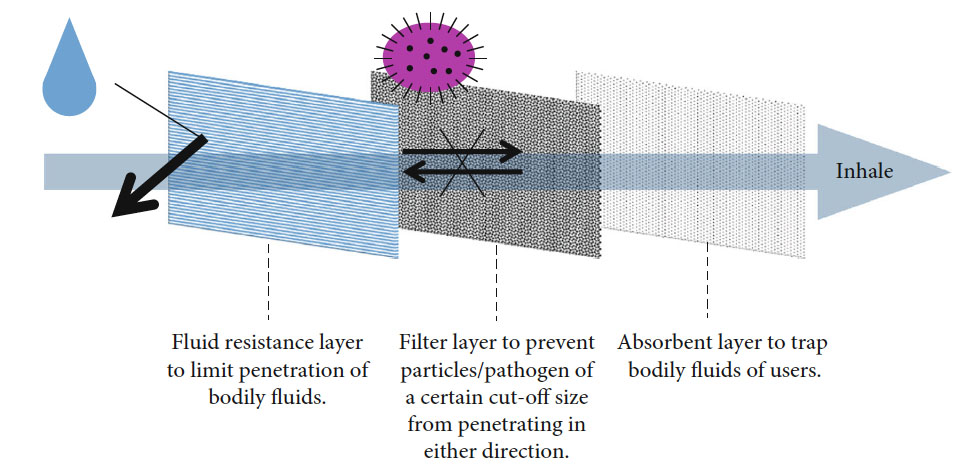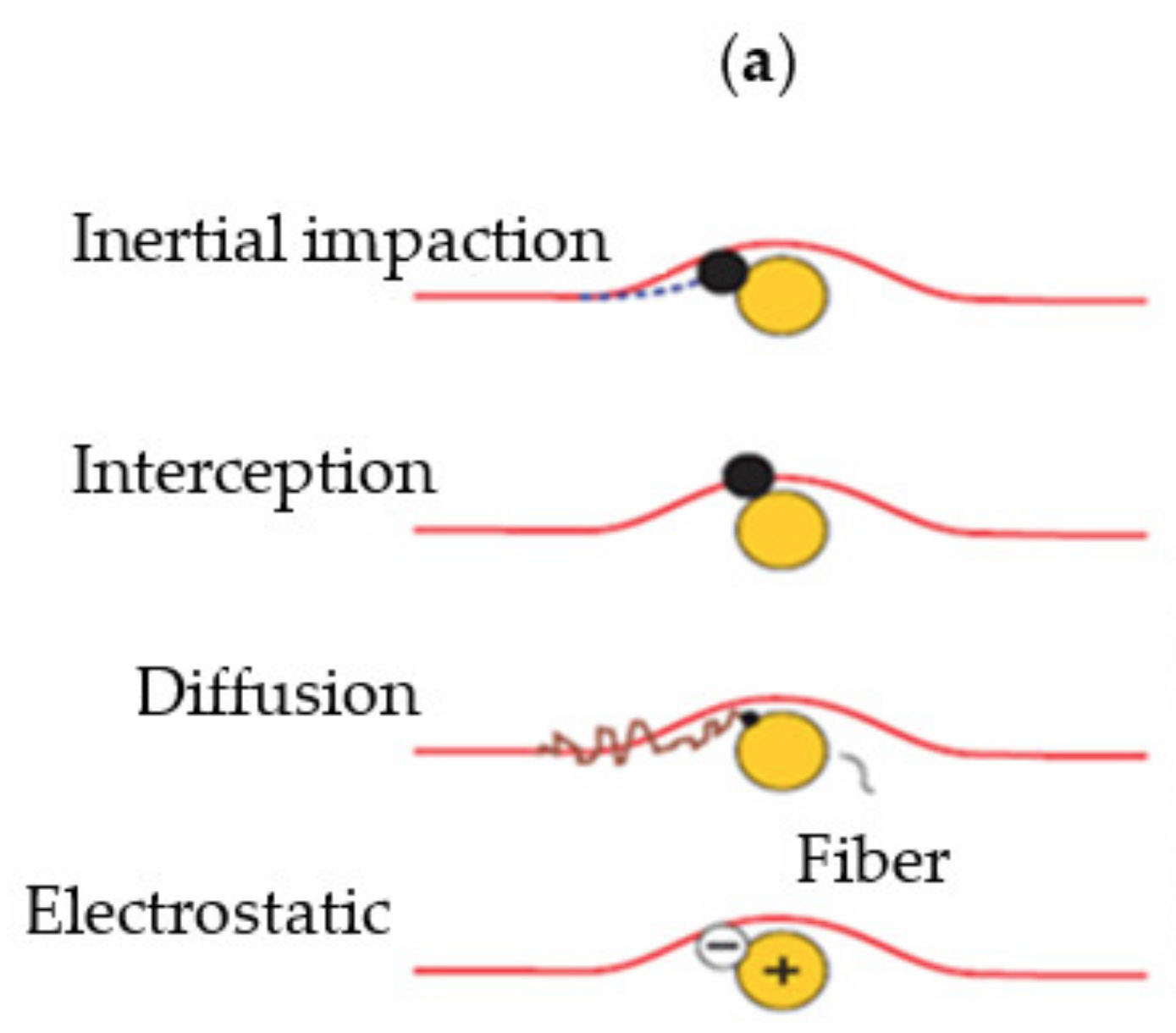| Mar 14, 2022 | |
Nanotechnology for face masks |
|
| (Nanowerk Spotlight) Triggered by the COVID-19 pandemic, the surge in demand for surgical masks and respirators has led to a global manufacturing rush. However, not all mask filter materials are suitable for all pollutants and pathogens since the contaminants in breathable air differ vastly in size. For instance, the SARS-CoV-2 virus has a size ranging from 60 to 140nm, smaller than bacteria, dust, pollen and other larger viruses. | |
| That means that for masks to be effective against a particular pathogen or pollutant, the pore size of their filtering material needs to be smaller than the size of the airborne droplets that contain the pathogen or pollutant it is intended to be used against. | |
| While face mask for pollutants are intended to protect the wearer from airborne particles, the primary role of face masks during the COVID-19 pandemic was to protect others from the droplets and particles the mask wearer breathes, coughs, or sneezes out (in order to make sure the wearer is protected from airborne viruses, the eyes also need to be covered since viruses can enter the body through all mucous membranes). | |
 |
|
| Relative size chart of common airborne contaminants and pathogens. (© AAAS Research) | |
| Face masks and respirators, both reusable or disposable, offer different levels of protection to users. Generally, masks do not fit tightly while respirators do. Reusable ones include industrial-use half or full facepiece respirators with cartridge filters attached and homemade or commercial cloth masks; disposable ones include most surgical masks. | |
| A 3-layer surgical mask has been commonly used in the COVID-19 pandemic. This mask is made up of 3 different layers of nonwoven fabric with each layer having a specific function, as illustrated below. | |
| The outermost layer is waterproof and helps to repel fluids such as mucosalivary droplets. The middle layer is the filter, which prevents particles or pathogens above a certain size from penetrating in either direction. The innermost layer is made of absorbent materials to trap mucosalivary droplets from the user. This layer also absorbs the moisture from exhaled air, thus improving comfort. | |
 |
|
| Illustration showing the function of each individual layer of a 3-layer surgical mask. (© AAAS Research) | |
| Together, these 3 layers effectively protect both the user and the surrounding people by limiting the penetration of particles and pathogens in both directions. | |
| Various parameters regulate filtration effectiveness, such as fiber diameter, porosity, and filter thickness. If the intended purpose is to filter out viruses, then the filtration material needs to be able to capture nanoscale particles. | |
| Manufacturers have developed different mask styles and air filtration materials using various nanomaterials – nanofibers, nanoparticles, graphene, metal-organic frameworks. | |
Nanofibers |
|
| For nanoscale filtration, various types of electrospun nanofibers (electrospinning typically generates fibers with diameters in the range of 50–100 nm) are by far the most used filter material. Filtering with nanofiber membranes is essentially performed through five collections of mechanisms: interception; inertial impaction; diffusion; gravitational settling; and electrostatic attraction. | |
 |
|
| Mechanisms of particle filtration. (© MDPI) | |
| Generally, all collection mechanisms illustrated above, except the electrostatic attraction, refer to mechanical filters and are affected by particle size and velocity. Interception and inertial impaction are commonly known to be predominant combination mechanisms for macro and microparticles (>0.3 µm), while diffusion is predominant for nanoparticles (<0.3 µm). | |
| An interception occurs when the particles follow the air stream around the fiber and come into contact with the fiber's surface, and deposit on it because of van der Waals forces. Inertial impaction occurs when the particle changes its streamline direction near a filter fiber and impacts the fiber due to inertia. Particles under 0.3 µm are mainly affected by diffusion where they move across streamlines (Brownian motion) until they contact the fiber, because of air molecules' random movements. In gravitational settling, and due to gravity, large particles may settle in slow movement airstreams. The electrostatic attraction works through the Columbia attraction, where charged particles are attracted to the fibers oppositely charged. | |
Metal nanoparticles |
|
| Nanoparticles of metal and their compounds have garnered huge attention as a potent antimicrobial agent due to their high surface-to-volume ratios compared with their bulky counterparts. Nanoparticles of silver silver compounds, copper, titanium dioxide, zinc oxide, and aluminum and aluminum oxide have been incorporated to various filters for antimicrobial properties. A synergistic antimicrobial performance is also revealed via their combination with other biocidal agents, such as carbon nanotubes. | |
| Four major interaction phases have been identified as to how these metal nanoparticles exhibit antiviral properties: | |
| 1) The nanoparticles attach themselves to the virus, which disrupts the virus from attaching it onto a potential host cell. | |
| 2) Air flow causes slight ionization of the metal nanoparticle layer on the surface. When the nanoparticle contacts bacteria or viruses, it can rapidly oxidize the core material of bacteria or viruses by stimulating the generation of reactive oxygen species to realize the inactivation effect. | |
| 3) When contact occurs, metal nanoparticles can adhere to the membrane walls of the microorganisms, causing the denaturation and deactivation of the specific proteins on the surface of the bacteria or viruses, subsequently followed by apoptosis. | |
| 4) They indirectly destroy the virus through activating the immune response of infected cells by simulating their nucleus – this inhibits the spread of the virus. | |
Graphene |
|
| Graphene is another promising nanomaterial in the fight against airborne pathogens. Graphene's substantial surface area-to-volume ratio provides the highest ligand contact area which can interact with the charged residue of virions to block microorganisms. | |
| Researchers have successfully produced anti-bacterial graphene masks with an efficiency of 80%, which can be enhanced to almost 100% with exposure to sunlight for around 10 minutes. | |
| However, the use of graphene in face masks is controversial due to potential health risks from inhaled graphene particles. For instance, Health Canada, the department of the Government of Canada responsible for national health policy, issued an advisory to Canadians not to use face masks that contain graphene. | |
Metal-organic frameworks (MOFs) |
|
| Metal-organic frameworks (MOFs) are a class of porous crystalline materials that are composed of transition-metal cations and coordinately bonded multidentate organic linkers. With high porosity, tunable pore size, rich functionalities, and good thermal stability, MOFs hold great promise as suitable candidates for air pollution filtration. | |
| Already, researchers have shown that embedding MOFs into nanofibers results in a superior capability of wind resistance without film failure. | |
| Researchers have also demonstrated the photocatalytic bactericidal properties of a series of metal-organic frameworks (MOFs) and their potentials in air pollution control and personal protection. | |
| At the time of writing this article there are no commercial MOF face masks on the market. | |
Quantum dots |
|
| Scientists believe that quantum dots have broad prospects as potential antiviral mask material for their antiviral effect. Although the use of quantum dots as antiviral agents has been demonstrated, their applications for mask production have not resulted in commercial mask products yet. | |
Global nanotechnology face mask database |
|
| For reference, we have compiled a global nanotechnology face mask database that currently contains 50 mask items including research work, of which 24 are commercial products. They include nanofiber, nanoparticle and graphene based mask filters. | |
| This database is a work in progress. Please let us know if we missed a product. | |
| In conclusion, since the beginning of the COVID-19 pandemic in 2020, researchers have intensified their efforts to improve the performance of antiviral face masks by adding various functionalities such as metal nanoparticles and herbal extracts to inactivate pathogens, using graphene to make masks photothermal and superhydrophobic, and even using triboelectric nanogenerators to prolong mask lifetime. | |
| For an extensive, in-depth review of masks for COVID-19 you might want to read this review article. | |
 By
Michael
Berger
– Michael is author of three books by the Royal Society of Chemistry:
Nano-Society: Pushing the Boundaries of Technology,
Nanotechnology: The Future is Tiny, and
Nanoengineering: The Skills and Tools Making Technology Invisible
Copyright ©
Nanowerk LLC
By
Michael
Berger
– Michael is author of three books by the Royal Society of Chemistry:
Nano-Society: Pushing the Boundaries of Technology,
Nanotechnology: The Future is Tiny, and
Nanoengineering: The Skills and Tools Making Technology Invisible
Copyright ©
Nanowerk LLC
|
|
|
Become a Spotlight guest author! Join our large and growing group of guest contributors. Have you just published a scientific paper or have other exciting developments to share with the nanotechnology community? Here is how to publish on nanowerk.com. |
|
